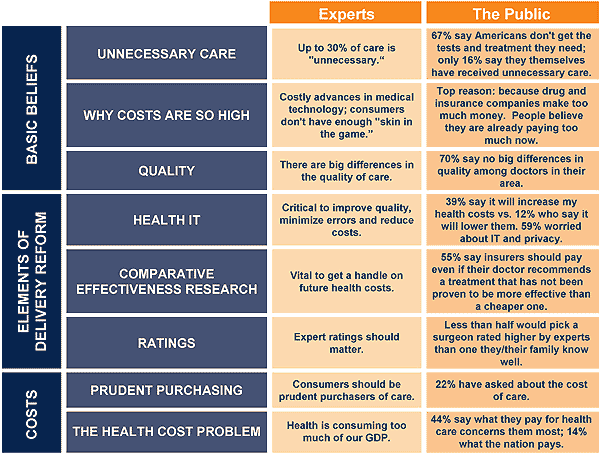Pulling it Together: The Experts vs. The Public on Health Reform
In repeated Kaiser polls, we see a divide between what experts believe and what the public believes about some of the key issues in health reform. They don’t disagree on everything; far from it. But there is a wide gulf on basic beliefs about what is behind the problems in the health care system and key elements of reform, especially delivery reform.
Experts believe the health care system is full of unnecessary care and troubling variations in care, and are committed to the long-term reform of the health care delivery system to make it more efficient, smooth out variations and produce greater value for the health care dollar. In this they (we) are of course right; it will not make sense over the long run to put more money into such an inefficient health care system. The public has a very different world view: People think that underservice is a bigger problem than overservice. They want relief from the problems they are having now paying for health care and health insurance in very tough economic times. Under no circumstances do they want to pay more for their care. And many are worried that they will not be able to afford their health insurance in the future or may lose it altogether.
People are likely to be perplexed when they hear experts say controlling health care costs may mean difficult tradeoffs in the high tech care they get or how much they have to pay out of pocket, because they don’t see the need for tradeoffs; more than anything else they blame waste and fraud and high profits made by insurance and drug companies for high health care costs. They don’t relate well to delivery reform because they don’t see problems in health care as systems failures as experts do and can’t easily see how delivery reform will help them with their day-to-day problems paying for care.
This chart shows a few of the areas where the experts and the public are at odds on basic beliefs about underlying problems, delivery reform, and health care costs.

These differences between experts and the public matter because key elements of health reform which elected officials expect to resonate with the public could get a decidedly less enthusiastic reception than expected if more is not done to close the gap in basic premises and beliefs between experts and the public. Most fundamentally, the challenge is to educate the public about why health costs are rising as fast as they are in the U.S. As long as people think we can solve the problem of rising health care costs simply by eliminating waste, fraud and profiteering, the hard choices they hear experts and leaders talking about will not make much sense to them. But it’s a lot easier to rail against the latest rip-off in the health care system if you are a politician or do another news story on Medicare fraud if you are a journalist than it is to talk about why medical technologies people want cost us so much. Perhaps we need Ross Perot back with his charts and graphs, this time with basic facts about why we have the problems we do in the health care system.
Another challenge is to explain how IT, and comparative effectiveness research, and pay for performance and the whole panoply of health systems changes that need to be made will help address the everyday problems of cost and access people care about most. Taking this communications challenge seriously is a necessary first step towards closing some of the gaps between experts and the public on health reform. Otherwise, key elements of reform will be susceptible to demagoguery and may not have the public support they deserve.
